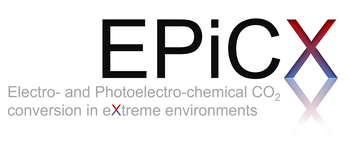Project outline

Over 80% of the world’s primary energy supply is currently provided by fossil fuels. This implies the release of about 34 Gt/y of CO2 into the atmosphere, which is the primary cause of global warming. Climate stability is a key prerequisite for the existence of modern civilization, therefore the decarbonization of the global economy is a pressing need in the interest of present and future generations. This dire need is exacerbated in extreme environments, where the delicate environmental equilibrium is easily shifted and where some cutting-edge research facilities are located (e.g. Concordia Station, Antartica).
This calls for an enhanced effort for research and development in this area, where the EPiCX proposal is positioned. Specifically, EPiCX targets a solar energy conversion device for the capture and conversion of carbon dioxide to valuable chemicals, both in conventional and extreme conditions, such as temperatures as low as -50°C. EPiCX aims to produce an optimized, fully operational photoelectrochemical (PEC) cell for the CO2 reduction reaction (CO2RR), either employing a single photoanode coupled to an electrocathode, or a combination of photoanode and photocathode in a tandem PEC configuration.
Particular focus will be placed on maximizing the selectivity towards products with significant added value at both the cathode and the anode by optimizing both composition and nanostructure of the materials. At the cathode, valuable hydrocarbons will be targeted using copper-based electrocatalysts with tailored surface structure such as nanocubes or colloidal nanoparticles, and through combination with inorganic co-catalysts. A fully photoelectrocatalytic approach will be explored by coupling the Cu nanostructures with Cu2O photocathodes.
At the photoanode, the advantageous properties of 2D material heterostructures and earth-abundant thin films will be exploited to go beyond the oxygen evolution reaction to more industrially relevant oxidation reactions such as imine synthesis and biomass valorization. A full suite of state-of-the-art operando characterization techniques, including electrochemical AFM, synchrotron XAS, and in-situ TEM, will be used to probe the fundamental and functional properties of the materials in real-time, providing invaluable feedback for their design and development. In an unprecedented step, the cell will be tested under extreme operating conditions mimicking those of polar and sub-polar regions, making use of the low temperatures to impart high reactant concentration by using liquid CO2 mixtures with organic solvents.
The project is divided into four scientific work packages for: design of CO2RR photoelectro- and electro-catalysts, optimization of the anodic compartment, structural and functional analysis, and development of a cryogenic high-pressure PEC cell. A fifth work package will be devoted to management and dissemination of the project.